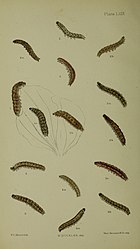Hoplodrina blanda
It is found in the Palearctic realm (Europe, Morocco, Iran, Russia – south Urals, and southwest Siberia).
Forewing fawn-tinged grey, with a fuscous suffusion, with the ground colour sometimes paler, more luteous ochreous, especially in examples from W. Turkestan; costal edge pale; inner and outer lines obscurely marked; the median and praesubmarginal shades distinct; stigmata fuscous grey, with pale annuli; hindwing whitish, grey-tinged towards termen; the veins and cell mark darker; altogether darker grey in the female.
nov. [Warren] though very possibly a distinct species; the ground colour of the forewing is paler, tinged with pinkish brown along the two folds, and the dark markings stand out more conspicuously; the costal edge is pale; the hindwing, even in the female, is whiter, showing a distinct cell spot.
Certain identification requires dissection of the genitalia.See Townsend et al.[2] The moth flies in one generation from late May to early September.
Larva ochreous with red or brown suffusion and dotted with dark; dorsal line yellowish edged with small black marks; subdorsal lines pale, dark-edged below; head pale marked with darker: on sundry low plants.
